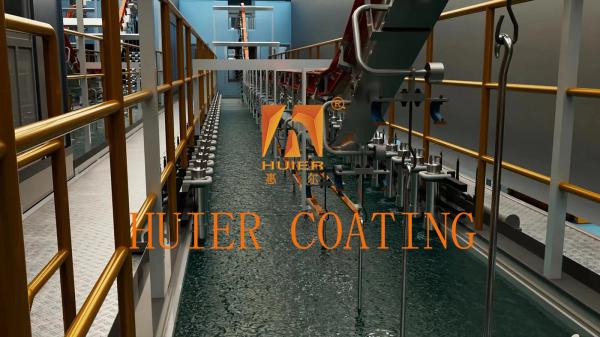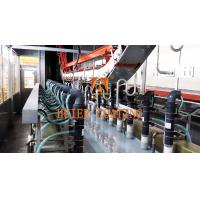Feature:
The water-soluble coatings used in electrophoretic coating have
high environmental protection. Its specific performance is: the use
of water-soluble paint in electrophoretic coating, more than 80% of
the paint is water, solvent volatilization is little, and the
pollution to the environment is correspondingly reduced.
Electrophoretic coating mainly uses acrylic resin or epoxy resin
(lead-free), which is not particularly toxic to the human body. The
paint taken out during the electrophoretic coating process can be
recycled 100%. Therefore, electrophoretic coating is one of the
most promising processes in the future development of coating. Five
specific features:
1, electrophoretic coating as a coating layer directly applied to
the metal surface, its coating rust resistance and binding force
can not be achieved by other coating.
2. Electrophoretic coating can be used as a coating treatment
process with one bottom surface, which can ensure the requirements
of coating in terms of performance and appearance. It can also
simplify the painting equipment and reduce the production cost.
3, greatly reduce the use of coating solvents, and reduce paint
dust and paint waste, conducive to environmental protection and
reduce the secondary pollution of paint waste.
4, in terms of film performance, it can improve the smoothness and
bonding force of the coating, reflect the metal texture, and
overcome the problems of traditional painting, such as flow hanging
and poor coating uniformity.
5, electrophoretic coatings can be recycled through ultrafiltration
or reverse osmosis devices to bring out the paint, to achieve the
recycling of resources, thereby reducing waste.
Care and maintenance:
Maintenance of the electrophoresis main tank circulation system In
order to ensure the smooth circulation of the electrophoresis main
tank, it is necessary to pay attention to the usual maintenance and
maintenance:
(1) The minimum circulation must be guaranteed: 4 times the amount
of liquid in the tank /hr, and insufficient circulation may cause
deposition at the bottom of the tank and deposition on the surface
of the workpiece.
(2) The minimum surface flow rate must be guaranteed: low surface
flow rate may cause deposition on the surface of the workpiece.
(3) The liquid level difference between the main and secondary
tanks must be ensured.
(4) It must be ensured that there is no spraying dead Angle at the
bottom of the tank: the falling off of the glass steel lining of
the tank body may cause repeated deposition of the coating,
corrosion of the tank wall, and leakage of electricity to threaten
personal safety.
(5) Proper filtration accuracy must be ensured: good filtration is
an important measure to ensure that the film is free of particles.
(6) It is necessary to ensure a good temperature-controlled heat
transfer system: circulation and electrophoretic heat transfer, and
control of the bath temperature is essential. Electrophoresis tank
liquid in the production process requires constant temperature, so
the circulating tank liquid must have a heat exchange system and
sufficient heat exchange capacity heat exchange medium temperature
requirements: cooling or heating: 5 ~ 15℃. It is recommended to
control the temperature of the tank during the long shutdown
period: 20 ~ 25℃
(7) It is necessary to filter the recovery of accumulated paint
when the tank is poured, which can greatly improve the utilization
rate of electrophoretic paint. The electrophoretic process is
divided into anode electrophoresis and cathode electrophoresis. If
the coating particles are negatively charged and the workpiece is
the anode, the coating particles in the electrophoretic process are
deposited into a film on the workpiece under the action of electric
field force. Electrophoretic process If the paint particles are
positively charged, the workpiece is the cathode, and the coating
particles deposited on the workpiece by the electrophoretic process
are called cathodic electrophoresis. The anodic electrophoresis has
lower technical requirements, and the corrosion resistance of the
coating is worse than that of the cathodic electrophoresis.
The main components of cathodic and anodic electrophoretic coatings
are as follows:
Cathodic electrophoretic coating
• Resin: It is the key ingredient, commonly used epoxy resin,
acrylic resin, polyurethane resin, etc. Epoxy resin provides good
adhesion and corrosion resistance; The acrylic resin can give the
coating good light preservation and weather resistance.
Polyurethane resin gives the coating excellent wear resistance and
flexibility.
• Pigments: inorganic and organic pigments. Inorganic pigments such
as titanium dioxide, carbon black, etc., can provide hiding power
and color; Organic pigments have bright color, strong coloring
power, and can meet decorative needs.
• Solvent: mainly water and a small amount of organic solvent.
Water as the main solvent makes the paint have good water
solubility and stability; Organic solvent can adjust the fluidity
and drying speed of the paint.
• Additives: including defoamer, leveling agent, neutralizer, light
stabilizer, etc. Defoamer can eliminate foam; The leveling agent
makes the coating surface smooth and smooth; The neutralizer is
used to adjust the pH value of the paint; The light stabilizer
improves the photoaging resistance of the coating.
Anodic electrophoretic coating
• Resin: Generally anionic resin containing carboxyl and other
acidic groups, such as acrylic resin, epoxy resin, etc. By
neutralizing with alkali to form water-soluble salt, the resin can
dissolve and disperse in water.
• Neutralizer: commonly used ammonia, organic amines, etc., react
with the acid groups in the resin to form water-soluble salts, so
that the resin can be dissolved in water to ensure the water
solubility of the paint.
• Hardener: such as melamine resin, which can cross-link with
specific functional groups of the resin to cure the coating during
baking, improving the hardness, water resistance and corrosion
resistance of the coating.
Solvent: Similar to cathodic electrophoretic coatings, water is the
main solvent, and a small amount of organic solvent is added to
help dissolve, adjust viscosity and improve the performance of the
film.
• Additives: levelling agents, antioxidants, etc. The leveling
agent improves the leveling property of the coating. Antioxidants
prevent paint from oxidizing and deteriorating during storage and
use.









